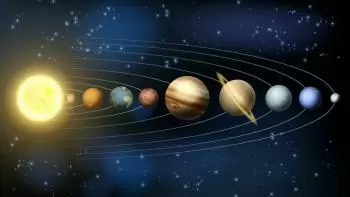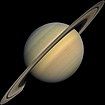
The Solar System formed about 4.6 billion years ago inside the Milky Way. The Solar System is the set of stars and celestial matter that orbit around the Sun.
The planets of the Solar System ordered by distance from the sun are Mercury, Venus, Earth, Mars, Jupiter, Saturn, Uranus, and Neptune.
Our planetary system distinguishes two types of planets:
-
Inner planets, which are the closest to the Sun and are rocky: The planets that make up this list are the planets Mercury, Venus, Earth, and Mars.
-
The outer planets are Jupiter, Saturn, Uranus, and Neptune.
What are the dwarf planets?
This list does not include the dwarf planets (Pluto and the Kuiper Belt objects, for example) defined by the International Astronomical Union on August 24, 2006.
This term was created to define a new class of celestial bodies, different from the classical and the minor planet.
Since then, Pluto has been removed from the list of planets in the Solar System.
What are the giant planets?
A giant planet is any planet much larger than Earth. They are usually made up mostly of low-boiling point materials ( gases or ice ) rather than rock or other solid matter, but massive solid planets can also exist. There are four known giant planets in the Solar System: Jupiter, Saturn, Uranus, and Neptune. Many giant extrasolar planets have been identified orbiting other stars.
What are the terrestrial planets?
A terrestrial planet - also called a telluric or rocky planet - is a planet made up mainly of silicates.
Terrestrial planets are substantially different from gas giant planets, which may not have a solid surface and are primarily made up of gases such as hydrogen, helium, and water in various states of aggregation.
All terrestrial planets have approximately the same structure: a metallic core, mostly iron, and a silicate mantle that surrounds it. The moon has a similar composition, except for the iron core. The terrestrial planets have canyons, craters, mountains, and volcanoes. They also have secondary atmospheres, coming from their internal geological processes, unlike the gas giants with primary atmospheres, captured directly from the original solar nebula.
1. Mercury
-
Planet Mercury is the closest planet to the Sun (82 million kilometers
-
Mercury is the minor planet in the Solar System (0.055 Earth masses)
-
It has no atmosphere, only slight traces of gas.
-
During the day, the soil reaches 427 ° C. At night, it can get -180 ° C.
2. Venus
-
Venus is the hottest planet in the Solar System. Its surface can reach temperatures above 450 ° C, probably due to the greenhouse gases in the atmosphere.
-
It is very similar in size to Earth (0.815 landmasses)
-
Has atmosphere
-
Internal geological agents are observed.
-
It has no natural satellites.
3. The Earth
-
It is the planet where we live.
-
It is the only planet on which current geological activity is known.
-
It is probably the only planet in the Solar System that supports life.
-
Its liquid hydrosphere is unique among the inner planets.
-
The atmosphere has been altered by the presence of life and is composed of 21% oxygen.
-
It has a natural satellite: the Moon.
-
It has changing distance throughout the year relative to the astronomical unit, too. For instance, when the Earth is at the nearest point to the sun for the year - January – it’s about 0.983 AU from the sun.
4. Mars, the red planet
-
Mars is smaller than Earth and Venus (0.107 Earth masses)
-
It has a calm atmosphere, composed mainly of carbon dioxide.
-
It has a red color derived from the presence of rust in the soil, rich in iron.
-
Mars has two tiny natural satellites (Deimos and Phobos).
5. Jupiter
-
Jupiter is the most giant planet in the Solar System, with 318 Earth masses.
-
It is located 778 million kilometers from the Sun
-
It takes 12 years to complete a trip around the Sun.
-
Its density is around 1.3 kg/dm 3.
-
It is a predominantly gaseous planet.
-
Jupiter has 79 known natural satellites.
-
Between Mars and Jupiter, there is the Asteroid Belt.
6. Saturn, the planet of the rings
-
Saturn is the planet with the most satellites orbiting around it: 82. Titan, one of them, is the only satellite in the Solar System with a dense nitrogen and methane atmosphere.
-
Saturn is distinguished by its ring system
-
It has 95 landmasses.
7. Uranus
-
Uranus has 14 Earth masses.
-
It is the only planet that orbits the Sun with an axial inclination more significant than 90 ° to the ecliptic.
-
It has an icy core compared to other gas giants, so it radiates very little heat into space.
-
Uranus has 27 known satellites.
8. Neptune
-
Neptune is the planet farthest from the Sun (4.3 billion kilometers).
-
The planet orbits the Sun every 164.8 years at an average distance of 30.1 AU (4.5 billion km; 2.8 billion mi).
-
It has 17 landmasses.
-
Neptune has 13 known satellites.







